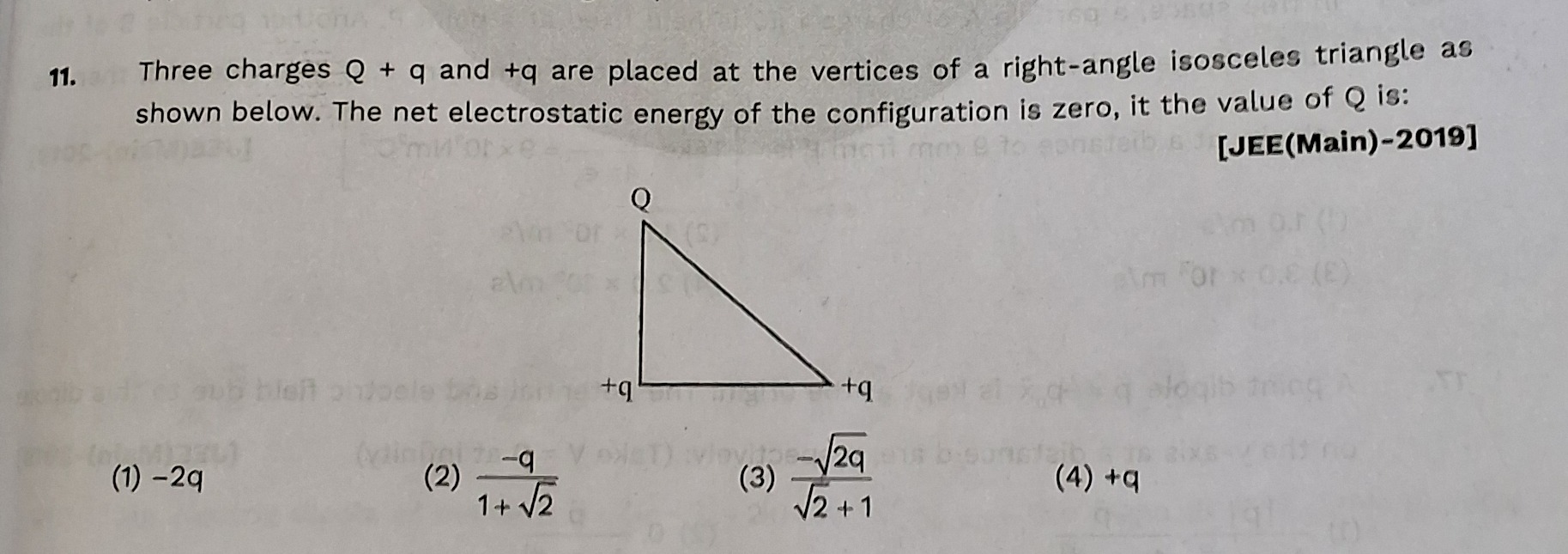Question
Question: Three charges Q + q and +q are placed at the vertices of a right-angle isosceles triangle as shown b...
Three charges Q + q and +q are placed at the vertices of a right-angle isosceles triangle as shown below. The net electrostatic energy of the configuration is zero, it the value of Q is:

-2q
1+2−q
2+1−2q
+q
2+1−2q
Solution
The charges are placed at the vertices of a right-angle isosceles triangle. Let the charge Q be placed at the vertex with the right angle. Let the two equal sides of the triangle have length 'a'. Then the other two charges +q and +q are placed at the other two vertices. The distance between the charge Q and each of the +q charges is 'a'. The distance between the two +q charges is the hypotenuse of the right-angled triangle, which has length a2+a2=a2.
The net electrostatic potential energy of the configuration is the sum of the potential energies of all pairs of charges. There are three pairs of charges:
- Charge Q and one charge +q, separated by distance 'a'. The potential energy is U1=4πϵ01aQq.
- Charge Q and the other charge +q, separated by distance 'a'. The potential energy is U2=4πϵ01aQq.
- The two charges +q and +q, separated by distance a2. The potential energy is U3=4πϵ01a2q⋅q=4πϵ01a2q2.
The net electrostatic energy of the configuration is the sum of these energies:
Unet=U1+U2+U3=4πϵ01aQq+4πϵ01aQq+4πϵ01a2q2
Unet=4πϵ01(a2Qq+a2q2)
We are given that the net electrostatic energy of the configuration is zero:
Unet=0
4πϵ01(a2Qq+a2q2)=0
Since 4πϵ01 and 'a' are non-zero (assuming the charges are not at the same location), the term in the parenthesis must be zero:
a2Qq+a2q2=0
We can multiply by 'a' (assuming a=0):
2Qq+2q2=0
Now, we solve for Q. Assuming q=0, we can divide by q:
2Q+2q=0
2Q=−2q
Q=−22q
To compare this with the options, we can rationalize the denominator:
Q=−22q×22=−2×2q2=−42q
Let's re-examine the options provided in the question.
(1) -2q (2) 1+2−q (3) 2+1−2q (4) +q
Let's simplify option (3) by rationalizing the denominator:
2+1−2q=2+1−2q×2−12−1=(2)2−12−2q(2−1)=2−1−q(2−2)=−q(2−2)=−2q+q2
Let's simplify option (2) by rationalizing the denominator:
1+2−q=1+2−q×2−12−1=(2)2−12−q(2−1)=2−1−q(2−1)=−q(2−1)=q−q2
None of the options match the calculated value Q=−22q.
However, let's reconsider the problem. It's a JEE(Main) question, so it's likely that one of the options is correct. Let's check if I misinterpreted the figure or the question. The figure clearly shows a right-angle isosceles triangle with Q at the right angle.
Let's assume there is a typo in my calculation or the options. Let's re-check the calculation.
2Qq+2q2=0
2Qq=−2q2
Q=−2q2q2=−22q
Let's look at the options again. Maybe there is a way to express −22q in one of the forms.
−22q=−2.828...q≈−0.3535q
Option (1): -2q Option (2): 1+2−q=1+1.414−q=2.414−q≈−0.414q Option (3): 2+1−2q=1.414+1−1.414q=2.414−1.414q≈−0.585q Option (4): +q
None of the options exactly match the calculated value. However, let's check if there is a relationship between my result and the options.
Let's consider option (3) again: 2+1−2q.
Let's see if Q=2+1−2q leads to Unet=0.
2Qq+2q2=0
2q(2+1−2q)+2q2=0
−2+122q2+2q2=0
Divide by q2 (assuming q=0):
−2+122+21=0
21=2+122
1×(2+1)=2×22
2+1=2×2=4
2=3
This is false. So option (3) is incorrect.
Let's consider option (2): Q=1+2−q.
2Qq+2q2=0
2q(1+2−q)+2q2=0
−1+22q2+2q2=0
Divide by q2:
−1+22+21=0
21=1+22
1×(1+2)=2×2
1+2=22
1=22−2=2
This is false. So option (2) is incorrect.
Let's re-examine the problem and the figure. Maybe the distances are not a, a, and a2. But given it's a right-angle isosceles triangle with charges at vertices, these distances are standard if we assume the lengths of the equal sides are 'a'.
Let's assume there is a typo in the question or options. Based on the standard calculation, Q=−22q.
Let's check if any option can be manipulated to get this form.
Option (3) is 2+1−2q.
My result is −22q.
Let's divide option (3) by 2: 2(2+1)−q=2+2−q. This is not equal to −22q.
Let's multiply my result by 2222 to get −22q.
Let's look at the options again. Option (3) is 2+1−2q.
Let's rewrite my result: Q=−22q.
Consider the ratio of magnitudes: ∣My resultOption (3)∣=−22q−2+12q=2+12×122=2+12×22=2+14.
This is not equal to 1.
Let's re-check the algebra for 2Qq+2q2=0.
2Qq=−2q2
Q=−2q2q2=−22q
Let's assume there is a typo in option (3) and it should be 2(2+1)−q2 or something similar.
Let's try to work backwards from option (3) and see if it makes sense in some context.
If Q=2+1−2q, then Unet=4πϵ0a1(2q(2+1−2q)+2q2)=4πϵ0aq2(−2+122+21).
For Unet=0, we need −2+122+21=0.
21=2+122
2+1=2×22
2+1=2×2=4
2=3, which is false.
Let's consider another possibility. Maybe the question intended for the distance between the two +q charges to be 'a', and the other two sides to be 2a. But this would not be a right-angle isosceles triangle with the right angle at Q as shown in the figure.
Let's go back to my original calculation. It seems correct based on the problem description and figure.
Q=−22q.
Let's look at option (3) again: 2+1−2q.
Let's try to multiply numerator and denominator by 2: 2+2−2q.
Let's rationalize: (2+2)(2−2)−2q(2−2)=4−2−2q(2−2)=2−2q(2−2)=−q(2−2)=−2q+q2.
Given that this is a JEE Main question, it is expected to have a correct option. Let me review my understanding of potential energy. The potential energy of a system of charges is the work done to assemble the charges from infinity. This is correctly calculated as the sum of potential energies of all pairs.
